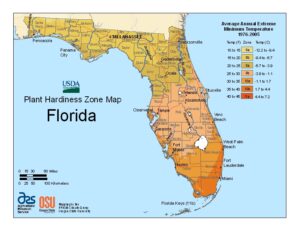
Landscape Plant Care Below Fifty Degrees
Why Plants Don’t Do Well Below Fifty Degrees
Plants have different optimal temperature ranges for growth, and most plants thrive in temperatures above 50 degrees Fahrenheit. Here are a few reasons why plants don’t do well at low temperatures, which ones are most susceptible, and tips for plant care below fifty degrees:
1. Slow growth: Cold temperatures slow down the growth processes of plants. Enzymatic reactions, nutrient uptake, and overall metabolic functions decrease when temperatures drop. This can result in stunted growth or dormancy until more favorable temperatures return.
2. Reduced nutrient uptake: Cold temperatures can affect the ability of plants to take up essential nutrients from the soil. The availability and solubility of nutrients can be compromised in colder soils, leading to nutrient deficiencies and poor growth.
3. Poor root development: Low temperatures can inhibit plant root growth and development. Roots need warmth to expand and absorb water and nutrients effectively. When roots struggle to develop, the overall health and vigor of the plant can suffer.
4. Increased susceptibility to diseases and pests: Cold temperatures can weaken plants’ natural defense mechanisms, making them more susceptible to diseases and insects. Some pests and pathogens also thrive in colder conditions, further damaging already stressed plants.
5. Frost damage: When temperatures drop below freezing point, the water in plants’ cells can freeze and expand, causing cell walls to rupture and damage the plant’s tissues. This can lead to wilting, discoloration, and, eventually, death.
You might also be interested in our Landscape Aftercare Guidelines for Rockaway Inc, Installations article.
It’s worth noting that not all plants are equally sensitive to cold temperatures. Some plants, known as frost-tolerant or cold-hardy species, have adaptations that enable them to withstand and even thrive in colder climates. These plants have mechanisms such as antifreeze proteins, protective hairs, or thicker 
Tropical Plants Begin to Suffer at Fifty Degrees & Below
Tropical plants typically thrive in temperatures ranging from 70 to 90 degrees Fahrenheit (21 to 32 degrees Celsius). However, specific temperature tolerances may vary between different plant species. As a general guideline, tropical plants may struggle when exposed to temperatures below 50 degrees Fahrenheit (10 degrees Celsius) or above 95 degrees Fahrenheit (35 degrees Celsius). It’s essential to research the specific needs of your tropical plants for more accurate temperature ranges. You might also be interested in our article, Tropical Plants Have Many Uses.
Best Ways to Prepare Plants As Temps Drop Below Fifty
As temperatures drop below fifty degrees, protecting your plants and ensuring their health is essential. Here are some of the best ways to prepare your plants for colder temperatures:
1. Bring potted plants inside: If you have potted plants that are sensitive to cold temperatures, it is best to bring them indoors. Find a suitable location with adequate sunlight and temperature conditions for each plant.
2. Mulch your garden beds: Apply a thick layer of organic mulch around the base of your plants in garden beds. Mulching helps insulate the soil, preventing it from cooling down too much and protecting the plant’s roots.
3. Water your plants appropriately: Water your plants deeply, especially before a frost or freeze, as moist soil can absorb and retain more heat than dry soil. However, be cautious not to overwater, as excessive soil moisture can lead to root rot and other complications.
4. Cover tender plants: Although ‘below 50’ is far from freezing, begin thinking ahead as you don’t want freezing temperatures to catch you off guard. Purchase frost blankets well in advance of the seasonal rush. Also, be prepared to use bed sheets or burlap to cover tender plants overnight when temperatures are expected to dip below freezing. Ensure the cover reaches the ground on all sides to trap the earth’s heat around the plant.
5. Group plants together: Cluster potted plants together on a porch or patio, as the combined heat from each plant can provide some extra protection. Additionally, surrounding walls or buildings can act as insulation.
6. Prune frost-sensitive plants in the Fall: Trim back any dead or damaged foliage from your plants before winter. Doing so will help redirect energy to healthier areas and minimize the risk of disease and pests.
7. Consider using plant shelters or cold frames: For more delicate plants or areas with prolonged freezing temperatures, you can opt for plant shelters or cold frames. These structures provide additional insulation and protection from the cold.
8. Monitor weather forecasts: Stay updated on the upcoming weather conditions and plan accordingly. Remember that different plants have varying degrees of cold tolerance, so it’s essential to research and understand the specific needs of each plant in your garden. We hope this article on plant care below fifty degrees is beneficial. You might also be interested in our article, Helping Your Plants Come Back After A Freeze.
From our office in Atlantic Beach and satellites throughout Northeast Florida, Rockaway Inc proudly serves both commercial and residential landscape design, maintenance, lawn care, irrigation, and outdoor living carpentry client needs in Jacksonville, St Augustine, Atlantic Beach, Neptune Beach, Jacksonville Beach, Ponte Vedra, Nocatee, St. Johns, and Fernandina Beach.
